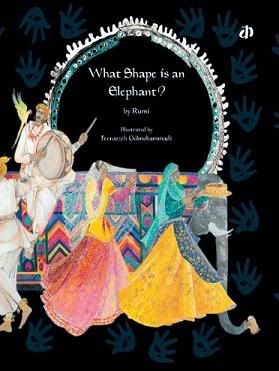WHAT SHAPE IS AN ELEPHANT?
What shape is an elephant? Is it round or crooked? Is it soft or is it coarse? These are the questions that go much deeper than they appear.
With this story, Katha introduces Rumi, the great Persian poet and philosopher, for the first time to young readers in India. Rumi's original version of the story of the elephant in a dark house seeks to explain why people have differing notions about Life and indeed, about God.
We try to understand Life as people try to understand the elephant in the story - by groping in the dark. But touching alone is no way of knowing. If we allow ourselves to look beyond, we shall behold more than our eyes can see and our hands can touch.
So open your mind's eye, and together with Rumi, see what you may have never seen before!
The Indian Express
(The School Magazine, May 24, 2006)
Have you read the poem The Blind Men and the Elephant by John G Saxe? It goes,
"There were six men of Hindustan
To learning much inclined,
Who went to see the elephant,
Though all of them were blind ...
The great Persian poet and philosopher Rumi had interpreted a verse of the Quran to explain the consequences of a group of Persians who tried to picture the elephant by feeling it. They had never seen the animal; and could not wait until daylight to satisfy their curiosity.
The story goes on to describe how they imagined the elephant, each by touching a part of the animal and thinking it was the whole.
Rumi's tale, which also formed the basis for Saxe's poem, explains how we must open our mind's eyes and look beyond things that are jst in front of us.
The book is made lively with colourful illustrations by
Feroozeh Golmohammadi, an Iranian artist. The paintings convey a poetic rhythm, with the illustrations, speaking as much as the words.
The book introduces Rumi to the readers and is simple and interesting in style.
-Anusha Chandrasekaran.
The Hindu
(Young World, June 9, 2006)
Books that are sure to keep you glued to its pages ...
TALES ON TAPESTRY - 2
Helping you to step into another magical world is the Persian poet and philosopher, Rumi's "What shape is an elephant?" Indian kids no doubt are familiar with the story. It is the story of people trying to identify the shape of an elephant in the dark and coming out with hilarious interpretations. But what makes this particular book special is the exquisite illustrations by Feeroozeh Golmohammadi. The brilliant innovation of the folded frieze is a bonus that would make one long to frame it as a treasured tapestry. And it is easy to imagine children poring over the pictures, living in the old world charm.
-Rohini Ramakrishnan
The illustrator
Feeroozeh Golmohammadi has been painting and illustrating children's books for nearly two and a half decades. She is among the first Iranian women to have won international acclaim in art and is credited with ushering in the renaissance of Persian miniature paintings.
She has to her credit a wide range of books that have won national and international awards, some of them being NOMA (thrice), Iran Gold Plaque and the Hans Christian Anderson Honorary Diploma. Her other interests include photography of which she's held several exhibitions across the world, and journalism. She has been the chief editor of the popular Iranian magazine Zan-e-Rooz.
The latest honour that she has received is the coveted grand prize in the first international Chitrakala contest conducted by Katha.
Publishers: Katha
32 pages, size 11 X 8.5
Age Group: 7 - 10 years
ISBN 81-89020-49-8 [PB]
ISBN 81-89020-48-X [HB]
Price: Rs 95 [PB]
Rs 150 [HB] (in India and the subcontinent)



0 Comments:
Post a Comment
<< Home